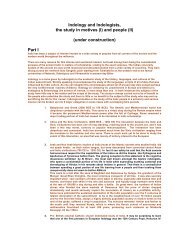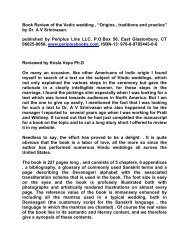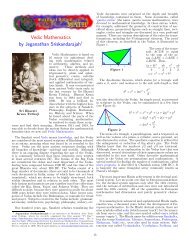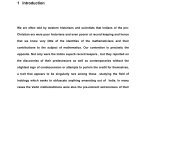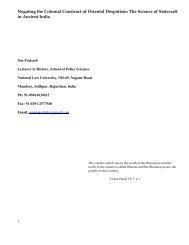The Dhaarmik Traditions - Indic Studies Foundation
The Dhaarmik Traditions - Indic Studies Foundation
The Dhaarmik Traditions - Indic Studies Foundation
You also want an ePaper? Increase the reach of your titles
YUMPU automatically turns print PDFs into web optimized ePapers that Google loves.
73 KAma ,काम "Pleasure,desire,wish, love; enjoyment." Earthly love, aesthetic and cultural fulfillment,<br />
pleasures of the world (often used in the sense of sexual desire, but not necessarily so),<br />
the joys of family, intellectual satisfaction. Enjoyment of happiness, security, creativity,<br />
usefulness and inspiration. An essential ingredient for the emotional health of an<br />
individual and recognized as such by the ancient Vedics. Kama is one of the four<br />
Purusharthas or goals of life, the others being dharma , artha and moksha.<br />
74 Kaarika Gloss or explanatory text of an original text, such as the Kaarika of the Mandukya<br />
Upanishad by Gaudapada<br />
75 Karma Yoga Karma yoga, or the "discipline of action" is based on the teachings of the Bhagavad Gita,<br />
a holy scripture of Hinduism. One of the four pillars of yoga, Karma yoga focuses on the<br />
adherence to duty (dharma) while remaining detached from the reward. It states that one<br />
can attain Moksha (salvation) by doing his duties in an unselfish manner. A great portion<br />
of the Bhagavad Gita is engaged in discussing the efficacy of various Yogas towards the<br />
goal of self realization or Moksha. Initially Arjuna is bewildered, when Bhagavan says<br />
that the Yoga of Knowledge is superior to the Yoga of action , even though desireless it<br />
may be. Why then do you ask me to fight asks an exasperated Arjuna of his friend and<br />
mentor, if such be the case. <strong>The</strong> answer by Bhagavan and elucidated by Adi Sankara in<br />
his Bhashya is one of the major insights of this lovely Celestial song. As explained by<br />
Adi Sankara, Karma Yoga consists of 4 principles 1. Giving up an egoistic attitude (BG<br />
18-46),2. Giving up the hankering for the fruits or results of one's action (BG 2-39), 3.<br />
Maintaining equalimity in the face of desirable andhappy circumstances as well as<br />
undesirable and not so pleasant situations (BG 2-48)4. Surrendering of all actions as an<br />
offering to the Lord (Ish<br />
76 Kshatriya,<br />
क्षिऽय<br />
the varna identified in the classical <strong>Indic</strong> tradition as those entitled to exercise military<br />
power and perform sacrifices, the dominant Guna in the Kshatriya varna is one of Rajas,<br />
and a passion for action. It is your Dharma to engage in action protect the aged and<br />
infirm and the children and women in your protection. It is better to follow ones own<br />
Dharma (dictated by ones Gunas) admonished Sri Krishna to Arjuna than to try<br />
something, however beguiling, which is not so suited<br />
77 Kurgan a region in Europe from where the putative immigration of the mythical Aryan race took<br />
place<br />
78 Kushana Empire<br />
79<br />
80<br />
81 mananam part of the process of gathering of kowledge using techniques such as<br />
sravanam,mananam and nididhyasanam. Mananam means to ponder over the material<br />
that one has read or heard<br />
82 Metonic cycle a cycle whereby every three years a lunar month is added to bring the lunar cycle in



